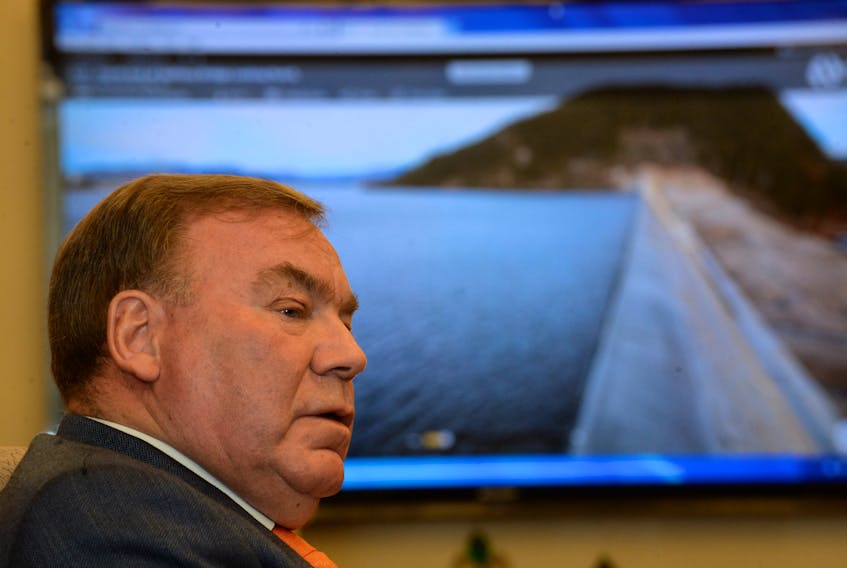ST. JOHN'S, N.L. — Nalcor Energy CEO Stan Marshall says it will take four to 10 months longer and potentially another $400 million to get the Muskrat Falls project to the finish line.
Construction on the project ground to a halt on March 17 when the coronavirus made its way to Newfoundland and Labrador, the day before a public health emergency was declared in the province.
The shutdown cost the project four months of construction time, and Marshall says the project could lose another two to six months of construction time once work resumes on May 30.
The delayed schedule means the cost of the project has increased, as well.
“Direct costs, maybe $150 million to $200 million. That’s a very rough estimate. Finance costs, maybe depending on the delay, it’s starting from a period of time, let’s say $200 million in finance costs,” said Marshall.
“You add those up and you get the result.”
Marshall emphasized these are early figures, largely used for internal planning by Nalcor. He says it will be September before a more certain cost and schedule estimate is determined for the project.
That means the $10.1 billion in base costs could rise to $10.3 billion. Financial costs continue to rise as well, by about $1 million a day, according to Marshall. The new estimated cost of the project could be as high as $13.1 billion, according to Marshall’s early estimates.
COVID-19 restrictions mean while work can resume by the end of the month, the number of workers allowed on the construction site will be much lower than before the shutdown.
“We’ll never get back to the workforce we had when we shut down. You’re probably talking, at best, maybe half,” said Marshall.
“That’s why with further delays we can’t make up for the loss of the last four months. We’ll lose more time.”
While construction is delayed, the first payments for the project are not.
“The first payment of principal interest come due in December — that’s $200 million. We won’t be up and operating by then, for sure,” said Marshall.
He says the federal government is aware of the situation and will have to be part of whatever solution comes next.
Consumer advocate Dennis Browne was blunt in his assessment of the latest cost and schedule overrun for the project.
“Muskrat Falls was the wrong project undertaken at the wrong time by neophyte project managers whose inexperience continues to haunt us financially,” Browne said.
LIL concerns continue
On May 19, Liberty Consulting issued another report on the status of the project, particularly with continued concerns for software needed to operate the Labrador-Island Link (LIL), the 1,200 kilometre transmission line needed to get electricity from Labrador to the island portion of the province.
The current schedule calls for the LIL to be operational by Dec. 1. Liberty says Nalcor Energy and Newfoundland and Labrador Hydro need to prepare for a scenario where the transmission line isn’t available this winter.
“The level of pessimism that now exists regarding LIL availability for the coming winter calls for an expedited effort to develop plans and the capability to operate without the LIL. Hydro should, as a matter of first priority, accelerate plans for identifying and executing plans for operating without the LIL this winter,” reads the report.
“We, like Nalcor and Hydro, hope that performance (and now work conditions) will improve soon enough to support LIL availability by this coming December. However, circumstances make it clear that reliance on that hope requires a backstop.”
Marshall says while work hasn’t gone as quickly on the LIL software, progress has been made toward a solution.
“Fortunately, during the four-month shutdown at Muskrat Falls, the development of software did not lose four months. They were able to carry on, again with reduced productivity, but software developers working for GE worked from home and did make progress,” he said.
“In some areas we did nothing, like the assembly of Muskrat Falls, where the software made progress, but not what you would have hoped if there had been no COVID.”
Marshall says the Holyroof Thermal Generating Station will continue to operate until the LIL is operational.
Soldiers Pond soldiers on
Elsewhere, vibrations at synchoronous condensors (SCs) at the Soldiers Pond site continue to be investigated.
The Liberty report says General Electric has issued a request for proposals for a solution to the vibration. The synchronous condensors are needed to stabilize electricity coming from Labrador. While not all three units are needed for the early operation of the transmission line, a solution is needed for when the project is complete.
"Progress is being made, but the information Nalcor reported to us does not support a reasonably firm conclusion that options identified so far will eliminate vibration as a source of limitation on synchronous condenser operations in the near term. We have also not seen a clear basis for determining what short- and long-range damage to the synchronous condensers the issues may cause (e.g., the time to failure of the SC if solutions do not completely obviate the issues that exist)," reads the report.
"We also do not believe there exists at present a basis for making realistic projections of the time it will take to get the SCs to a point where vibration issues will not delay their commissioning."
@DavidMaherNL









